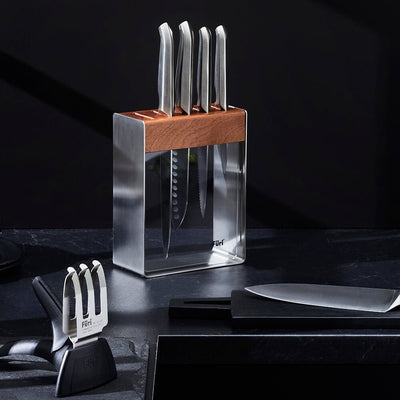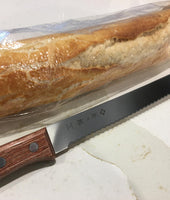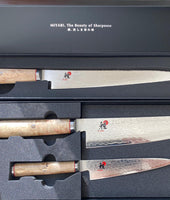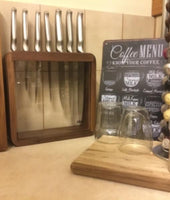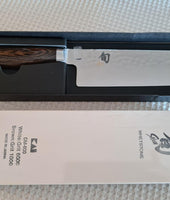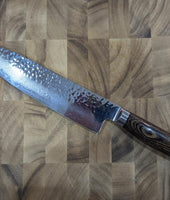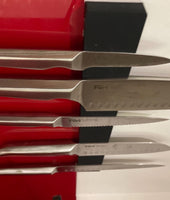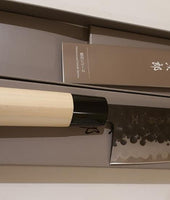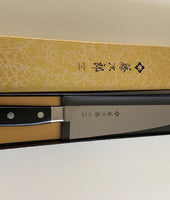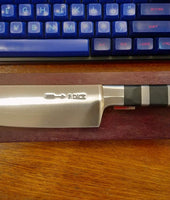If you're serious about cooking, you've probably heard people gushing about Japanese knives and how awesome they are. This is true. Japan has a long history of sword making, and a lot of that skill goes into the knives they make today. A number of things make Japanese knives unique and we'll look at some of them. We'll also look at some common types of Japanese knives. Here goes!
Features of Japanese Knives
Blade Thickness
The thickness of the blade determines how much fine work the knife can do. The thinner the blade, the finer the work. Japanese knives are very thin because Japanese cuisine features a lot of finely prepared ingredients.
Also, the Japanese diet is more of poultry and fish, which require delicate handling rather than beef and tough meat like the western diet. Thin knives are also light, which works well for precision cutting and dexterous maneuvers.
Flat or Curved?
The curvature of a blade will determine how you cut with it. Japanese knives tend to be flat along the cutting edge, which means they're best used in the chopping motion, rather than the rocking motion which works better on a curved blade.
The Type of Steel
The type of steel used to make a knife is important because it will determine how sharp the knife can get and how long it will remain sharp. Japanese knives use hard steel, measuring between 59 to 64 HRC on the Rockwell scale.
The Miyabi 5000FCD Nakiri Vegetable Knife 17cm, for instance, has a Rockwell hardness of 61. That's pretty hard, compared to German knives which range between 55 to 58 HRC.
Hard steel knives remain sharper for longer. The downside of using hard steel is that it is more difficult to sharpen once it gets dull. Hard steel is also more brittle than soft steel. It can break or chip easily, so you have to handle Japanese knives with care.
Single or Double Bevel?
Traditional Japanese knives have only one side of the blade sharpened. So, one side of the blade is flat or slightly concave, while the other is sharpened to a fine point. In knifespeak, we say they are single beveled. The single bevel allows you to sharpen the blocks knife to a finer point than a double bevel.
Single bevel knives are more difficult to use than the more common double bevel knives. They're harder to control. They're also harder to sharpen because you have to consider the angle of the bevel. They are mostly used in Japanese and professional kitchens.
Because of western influence, a number of Japanese knives are now double-beveled to cater to people who like the exquisite workmanship of Japanese knives but can't handle the single bevel.
The Angle of the Edge
If you're wondering what makes Japanese knives so much sharper than other knives, wonder no more! The angle is everything. The smaller it is, the sharper the knife will be.
Japanese knives are usually sharpened to an angle of about 10 to 15 degrees on one side. For instance, the Shun Kai Classic Sumo Santoku Knife 19cm features a 16-degree angle on its blade. A German knife blade angle will measure between 20 to 22 degrees. That's almost double.
The small-angle is made possible by the steel, which if you remember, is harder in Japanese knives. What does that mean for performance? It means that Japanese knives can cut more delicate ingredients and will cut finer.
There's a catch though. The narrower the blade, the more fragile it will be. Japanese knives damage more easily than their sturdier German counterparts. German knives are also better at cutting heavier and tougher ingredients.
Types of Japanese Knives
We've more or less seen some common features of Japanese knives. Let's now see some of the most common Japanese knives.
Gyuto
This is the Japanese version of the western chef knife. Like the chef knife, it is multi-purpose. You can use it to cut both vegetables and meat, and even fish. Unlike traditional Japanese knives, Gyuto knives like the F Dick Premier Plus Gyuto 18cm have a curved blade, which allows for rocking cuts.
Deba
Not all Japanese knives are feather-light. The Deba is a heavy knife with a thick spine. It is used primarily on fish and crustaceans.
The Tojiro Pro Flash 63 Layer Damascus Deba Knife 16cm can also be used on poultry.
The Deba's thick spine and heavyweight allow you to cleanly cut off the head of a fish and cut through the fish bones as well. Despite the heaviness of the blade and the thick spine, the Deba still features a very thin single beveled edge, so it's still very sharp and very fragile.
Nakiri
Nakiri means a vegetable knife. It's the knife you use when you've got some serious vegetable cutting to do. To an inexperienced observer, the Nakiri resembles a meat cleaver. This comes as no surprise as, like the meat cleaver, it has a broad blade with a square tip and a flat cutting edge. It is however smaller, thinner, and lighter and would probably chip if you used it on the bone. The broad Nakiri blade is useful for thick, hard vegetables that the Gyuto might find challenging, like squash.
Shun Kai Kaji Nakiri Knife 16.5cm
Usuba
Usuba is the Nakiri for professionals. It literally means 'thin blade' and boy it is thin! It is single beveled and hence requires more skill to use compared to the Nakiri. It can make wonderfully thin and precise cuts and is great for really delicate work.
F Dick Premier Plus Usuba Vegetable Knife 18cm
Santoku
No list of Japanese knives is ever complete without the Santoku. It literally means ‘three virtues' which refer to its triple ability to cut, dice, and slice meat, fish, and vegetables. It sort of does the same thing as the Gyuto, but it's smaller, flatter, and less pointed at the tip. It's useful if you have a small working space.
Miyabi 5000FCD Santoku Knife 18cm
Final Words
Japanese knives guarantee good workmanship, sharpness, and reliability. They're a good companion to have in the kitchen. Check out the types discussed in this post and take your pick!
Explore More Products: Tojiro Shippu Chef Knife 18cm | Tojiro Shippu Chef Knife 21cm |Tojiro Shippu Chef Knife 27cm |Victorinox Fibrox Flat Tines Carving Fork 15cm Yellow


























